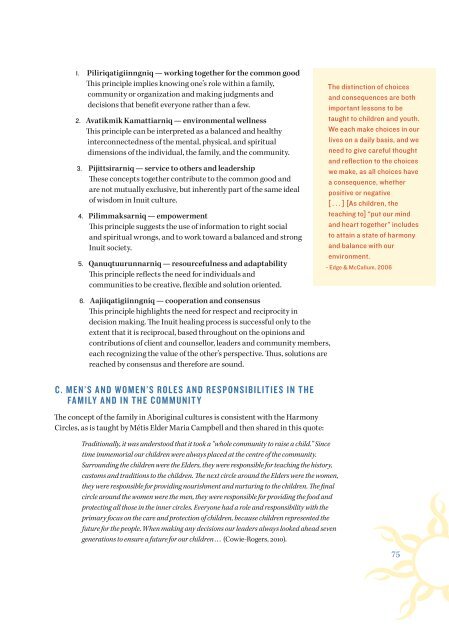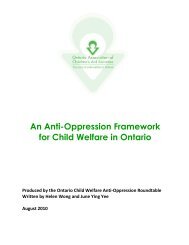English - Ontario Association of Children's Aid Societies
English - Ontario Association of Children's Aid Societies
English - Ontario Association of Children's Aid Societies
Create successful ePaper yourself
Turn your PDF publications into a flip-book with our unique Google optimized e-Paper software.
1. Piliriqatigiinngniq — working together for the common good<br />
This principle implies knowing one’s role within a family,<br />
community or organization and making judgments and<br />
decisions that benefit everyone rather than a few.<br />
2. Avatikmik Kamattiarniq — environmental wellness<br />
This principle can be interpreted as a balanced and healthy<br />
interconnectedness <strong>of</strong> the mental, physical, and spiritual<br />
dimensions <strong>of</strong> the individual, the family, and the community.<br />
3. Pijittsirarniq — service to others and leadership<br />
These concepts together contribute to the common good and<br />
are not mutually exclusive, but inherently part <strong>of</strong> the same ideal<br />
<strong>of</strong> wisdom in Inuit culture.<br />
4. Pilimmaksarniq — empowerment<br />
This principle suggests the use <strong>of</strong> information to right social<br />
and spiritual wrongs, and to work toward a balanced and strong<br />
Inuit society.<br />
5. Qanuqtuurunnarniq — resourcefulness and adaptability<br />
This principle reflects the need for individuals and<br />
communities to be creative, flexible and solution oriented.<br />
6. Aajiiqatigiinngniq — cooperation and consensus<br />
This principle highlights the need for respect and reciprocity in<br />
decision making. The Inuit healing process is successful only to the<br />
extent that it is reciprocal, based throughout on the opinions and<br />
contributions <strong>of</strong> client and counsellor, leaders and community members,<br />
each recognizing the value <strong>of</strong> the other’s perspective. Thus, solutions are<br />
reached by consensus and therefore are sound.<br />
C. MEN’S AND WOMEN’S ROLES AND RESPONSIBILITIES IN THE<br />
FAMILY AND IN THE COMMUNITY<br />
The concept <strong>of</strong> the family in Aboriginal cultures is consistent with the Harmony<br />
Circles, as is taught by Métis Elder Maria Campbell and then shared in this quote:<br />
The distinction <strong>of</strong> choices<br />
and consequences are both<br />
important lessons to be<br />
taught to children and youth.<br />
We each make choices in our<br />
lives on a daily basis, and we<br />
need to give careful thought<br />
and reflection to the choices<br />
we make, as all choices have<br />
a consequence, whether<br />
positive or negative<br />
[ . . . ] [As children, the<br />
teaching to] “put our mind<br />
and heart together” includes<br />
to attain a state <strong>of</strong> harmony<br />
and balance with our<br />
environment.<br />
- Edge & McCallum, 2006<br />
Traditionally, it was understood that it took a “whole community to raise a child.” Since<br />
time immemorial our children were always placed at the centre <strong>of</strong> the community.<br />
Surrounding the children were the Elders, they were responsible for teaching the history,<br />
customs and traditions to the children. The next circle around the Elders were the women,<br />
they were responsible for providing nourishment and nurturing to the children. The final<br />
circle around the women were the men, they were responsible for providing the food and<br />
protecting all those in the inner circles. Everyone had a role and responsibility with the<br />
primary focus on the care and protection <strong>of</strong> children, because children represented the<br />
future for the people. When making any decisions our leaders always looked ahead seven<br />
generations to ensure a future for our children . . . (Cowie-Rogers, 2010).<br />
75

















